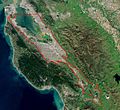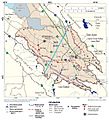Santa Clara valley aquifer facts for kids
The Santa Clara Valley Aquifer is like a giant underground sponge that holds water in the southern San Francisco Bay Area. This water is called groundwater. It's a really important source of water for the people living there. The ground under the valley has many different layers of rock and soil, some that let water through easily and some that don't. The Santa Clara Valley Water District helps manage this important water supply.
Contents
A Look Back: How the Aquifer Changed
In the first half of the 1900s, more and more people moved to the Bay Area. This meant they needed more water. So, they started pumping a lot of water from the aquifer.
Between 1912 and 1966, the natural pressure that pushed water up from deep underground dropped a lot. It went down by as much as 200 ft (61 m)! When this pressure dropped, the ground above the aquifer started to sink. This sinking is called land subsidence. Some areas sank by as much as 15 ft (4.6 m).
Good news! In recent years, people have learned better ways to manage the aquifer. Because of these new methods, the ground has stopped sinking.
Deep Dive: Understanding the Aquifer's Layers
Scientists have studied the Santa Clara Valley Aquifer by drilling deep holes and taking samples. These samples show that the aquifer has about four to six different layers that hold water.
Some of these water layers are confined, meaning they are trapped between layers of rock that water can't easily pass through. Other layers are unconfined, which means they are closer to the surface and can get water directly from rain or rivers.
The layers that hold water are usually made of coarse materials, like sand and gravel. These are separated by thinner layers of fine materials, like clay. The thick water-holding layers can be 10 to 25 ft (3.0 to 7.6 m) thick in the southeast part of the valley. In the south-central and southwestern areas, they can be much thicker, from 50 to 200 ft (15 to 61 m).
By checking the temperature of the water in special monitoring wells, scientists can tell that most of the underground water flows horizontally. This flow happens mostly above 775 ft (236 m) deep in the south-central areas and above 510 ft (160 m) in the southeastern areas.
Taking Care of Our Water: Management Efforts
The Santa Clara Valley Water District is in charge of several important things for Santa Clara County, California. They work to protect streams, provide water to homes and businesses, and help prevent floods. All these efforts help keep the Santa Clara Valley Aquifer healthy and full of water for everyone.
Images for kids



